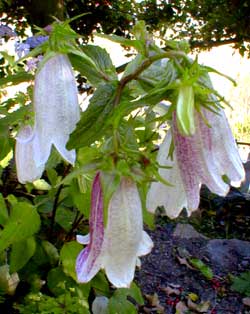
Korean Campanula
"In a flowered dell the Lady Venus stood,
Amazed with sorrow."
-Rupert Brooke
(1887-1915)
(1887-1915)
Comparatively new in western gardens, Campanula takesimana or Korean Bellflower produces a groundcover of rosettes of shiny heart-shaped leaves with very beautiful rust-red & bronzy sheens. From this base it sends up sweeping sprays of leafy stems topped with large pendant flowers.
Though the species was described to gardeners in the 1920s, it was not soon available to gardeners. The original strain modernly made available for western gardeners came from an island off Korea called Ullung-do in the Sea of Japan, & even this was for some while on the "Pink List" of the National Council for the Conservation of Plants & Gardens. The Pink List designates plants considered rare in cultivation. This list guaranteed a deserved if belated attentiveness, & so the species was not long on the rarities list.
Ours is growing in a bright-shade garden underneath the Paperbark Maple with Tiarellas & May Apples & a Mouse Plant & other such items as love the shade. Most of our campanulas are such sun-lovers, & it is nice to have one that brings bellflowers into darker margins of the garden.
Korean campanulas also do fine in morning sun, & the further north they are grown, the more sun they may require. They don't need a lot of water.
The stems that rise from basal leaves reach twenty inches or so, weighted to a fountaining sweep by pendulous palest lilac-hued white slender tubular bells, spotted maroon on the interior, with some of the blooms having rosy streaks on the outside. These blooms dangle straight downward & last the entire summer, with rebloom in autumn, especially if deadheaded.
It should be fertilized twice a year for it to sustain such floral excellence. If these blooms have any fault at all, it is in the fact that by placing them near the humbly blooming Tiarellas, they make the fluffy flowers of the Tiarellas almost invisible by comparison. Greatly in its favor, many of the shade plants have a reduced summer presence or completely estivate in summer, but the beautiful leaves & flowers of the Korean bellflower will keep things lively even when jack-in-the-pulpits, trilliums, mouseplant, & other such plants have reduced their presence.
The basal leaves last quite some while into winter as well, & in some conditions may be nearly evergreen. In our shade garden, however, even though well protected & experiencing only mild winters, it entirely dies to the ground by late December. It is not long missing, as it returns fresh from the ground early March, though waiting until June to start flowering again.
Because it was for some while rare in the nursery trade, it had no cultivars, but with the growing availability of the species, cultivars were inevitable. Pale pink 'Elizabeth' erupted in the nursery of Elizabeth Strangmen in Kent. 'Alba,' a pure white form, is also available. 'Beautiful Truth' has white strap-like reflexed flower petals & scarsely looks like the same species. Although the strap-flowered variant was accidentally patented under the name 'Beautiful Trust,' its real name is 'Beautiful Truth,' the literal translation of its Korean name, having been given the name of the daughter of Song Kihun of the Chollipo Arboretum in South Korea. This variety was first introduced in America by Heronswood Nursery which is near our home.
The species produces cultivation-worthy sports with some regularity, so more & more cultivars can be expected as time passes. I may add others to our garden someday, but I certainly don't feel deprived to have only the original wild form.
Our clump began from a veritable seedling & didn't spread far during its first four seasons. It seriously picked up steam its second year. It is potentially aggressive with its underground rhizomes. It is best not to let it go to seed, so that its spread remains controllable, though its primary spread will be rhizomes even if it is not deadheaded.
It by no means equals C. punctata in aggressive potential, but some attention is required, & I did transplant our expanding clump further away from the Mouse Plant which I feared the Korean Bellflower was apt to overwhelm.
It can easily spread to two feet, & will need Autumn division every three our four years, less often in conditions that are occasionally droughty, or sooner if one is eager to propagate new clumps.
Campanula poscharskyana,
Serbian Bellflower